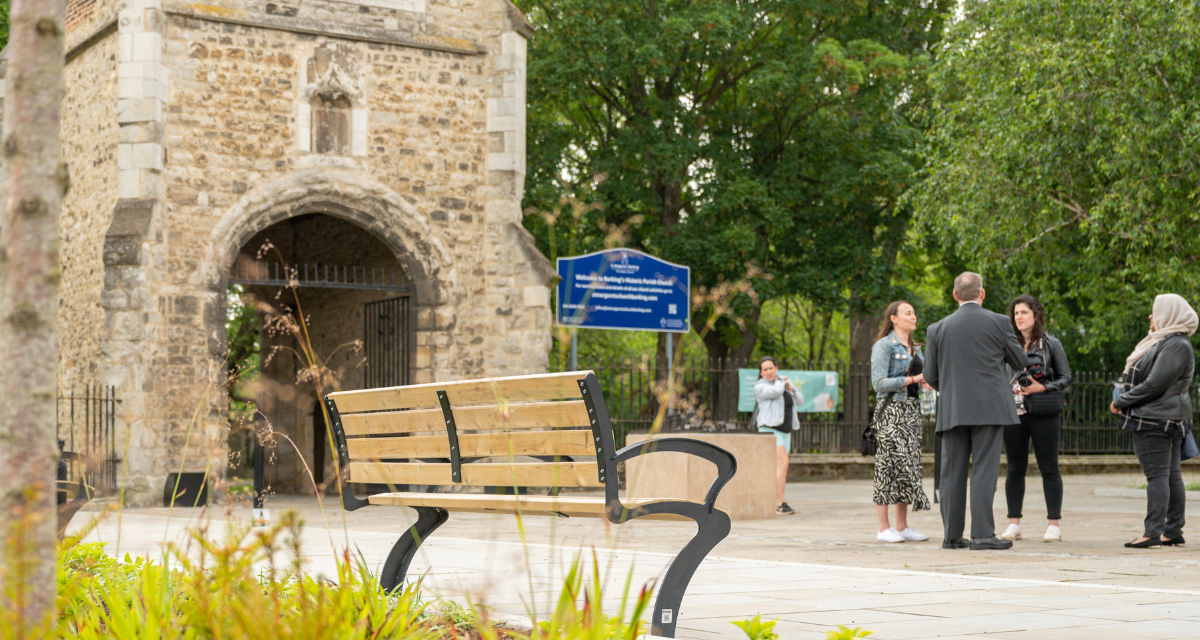Ruins of the medieval Barking Abbey destroyed during the Reformation 500 years ago have been restored and landscaped as part of Barking town centre’s ambitious heritage project.
The Abbey Green site includes the 14th century Curfew Tower as well as the famous “Three Lamps” from a later era that have been the focus of political and industrial protest for 150 years.
The rejuvenated Abbey Green was officially opened by the leader of Barking and Dagenham Council, Darren Rodwell, to promote the town’s colourful but turbulent past.
“This makes more people aware of our rich heritage,” Cllr Rodwell explained.
“You need to know your town’s history to plan for the future. This scheme shows how improvements can do this.”
The Curfew Tower, or Fire Bell Gate, is the only remaining gateway of Barking’s ancient Saxon abbey, predating the Norman Conquest, a Grade II-listed structure that was added in 1370.
Its bell rang to remind “the good citizens of Barking” to put out fires and lights before the nightly curfew, a practice which continued till 1900!
A chapel built into the tower holds the Holy Rood, a stone relic pilgrims visited in medieval times which survived the demolition of the abbey during Henry VIII’s Reformation purge, along with the Abbey Gate itself.
The abbey ruins are listed as a “scheduled monument” by Historic England which are the focus of the town centre’s heritage conservation project.
Pupils from St Joseph’s and St Margaret’s primary schools buried a time capsule of writings and drawings about Barking’s past, present and even its future, before contractors finished landscaping the area to create the public space.
The landscaping opens the view of the Curfew Tower from East Street, which had been obscured for decades. York stone has been re-set with a cobbled border to trace an ancient church path and draw people towards the medieval gateway and towards St Margaret’s Church.
The protest heritage of the Abbey Green’s Three Lamps have also been preserved as part of the project.
Barking has a history of protest against inequality and injustice and campaigning for equal rights. The Three Lamps have stood close to Barking Broadway for more than a century, where people gathered to demonstrate, from trade unionists to suffragettes.
A photograph from local authority archives shows the original position of the Three Lamps outside the George Inn at The Broadway in the late 19th century, originally lit by oil or gas.
Trade unions were among the earliest protestors to gather by the lamps, most likely workers from Barking gasworks at Beckton from 1870. The 1,000 gas workers protested to reduce their hours from 12 a day to eight. The unions also supported the 1889 women Jute workers’ strike in Barking.
Campaigners in the 20th century included the women machinists on strike at Ford Dagenham works in 1968 who eventually won their 20-year campaign by the 1980s for equal pay.
The oil lamps ironically have shone a light more recently on global warming protests, a site of ancient struggles stretching back to Saxon times.
Join the exciting world of cryptocurrency trading with ByBit! As a new trader, you can benefit from a $10 bonus and up to $1,000 in rewards when you register using our referral link. With ByBit’s user-friendly platform and advanced trading tools, you can take advantage of cryptocurrency volatility and potentially make significant profits. Don’t miss this opportunity – sign up now and start trading!










Recent Comments